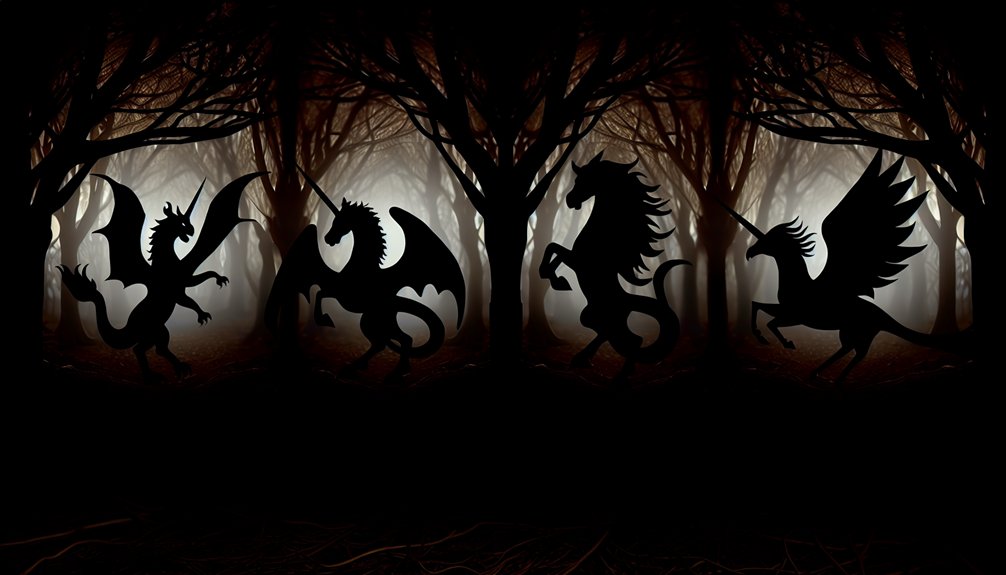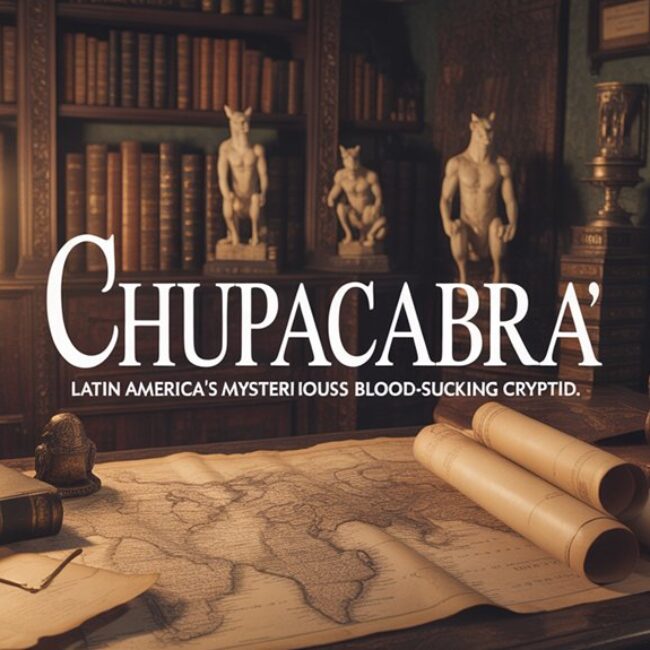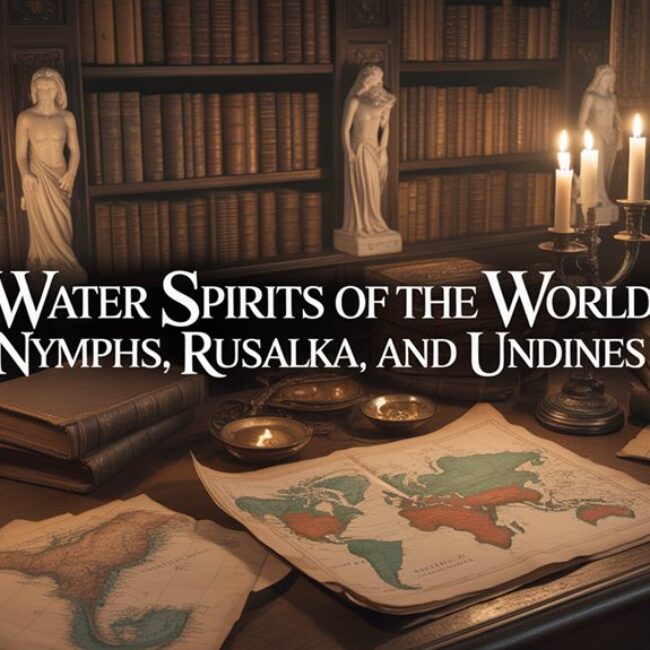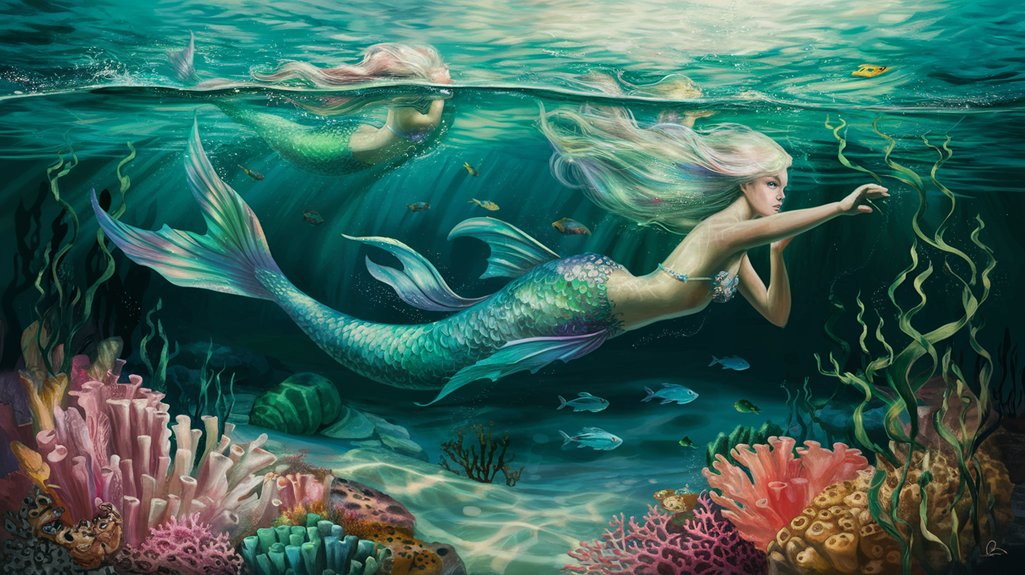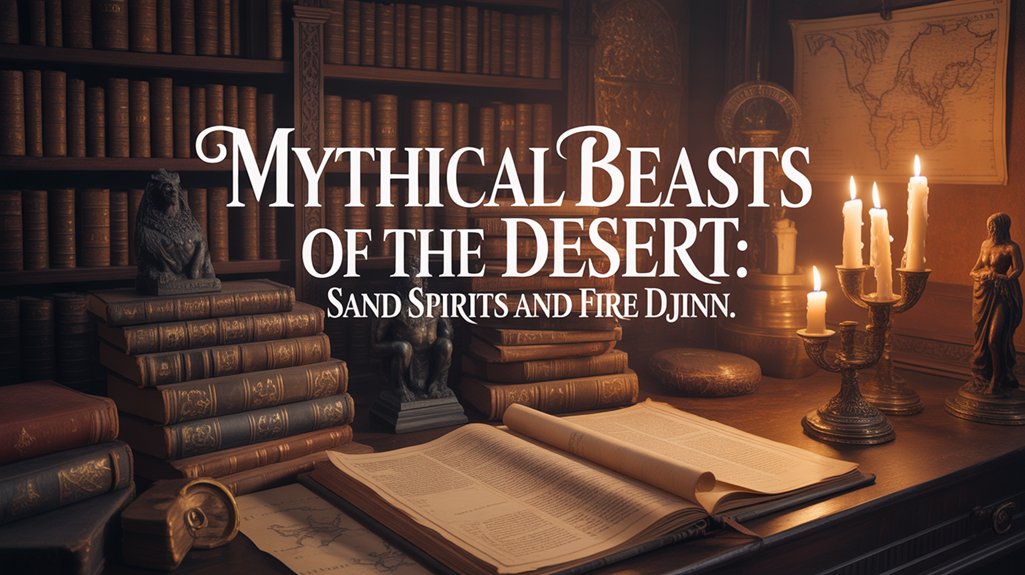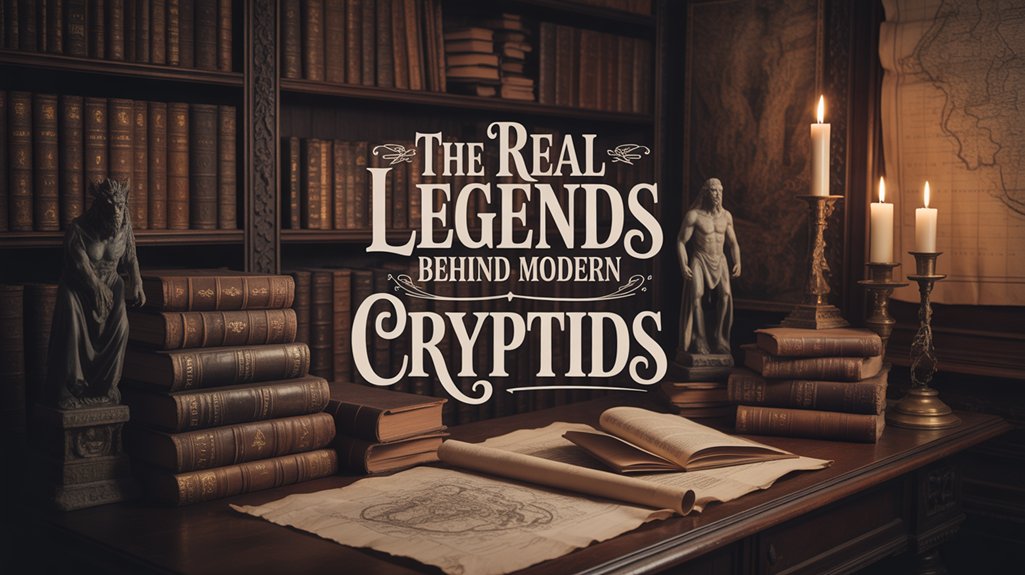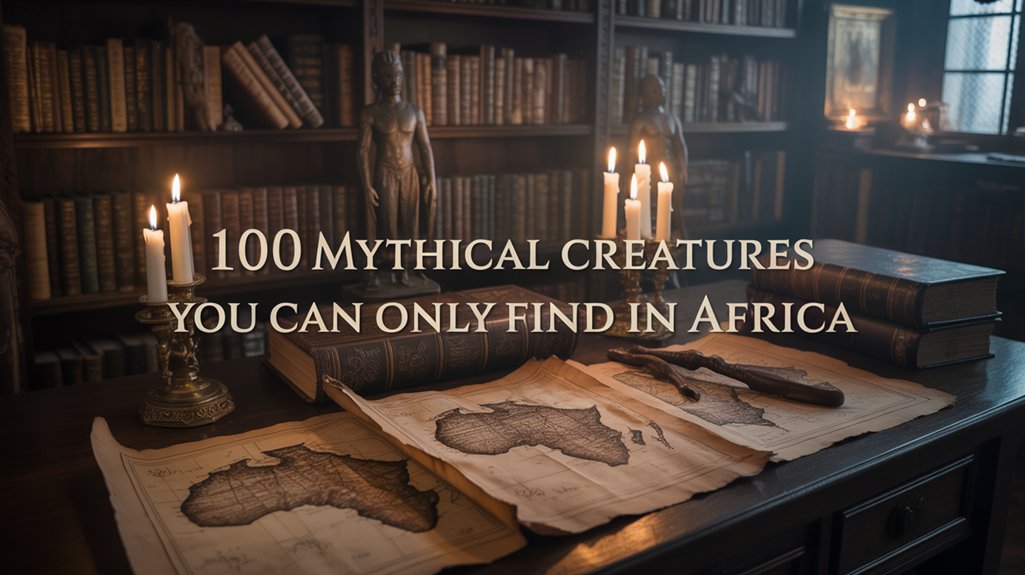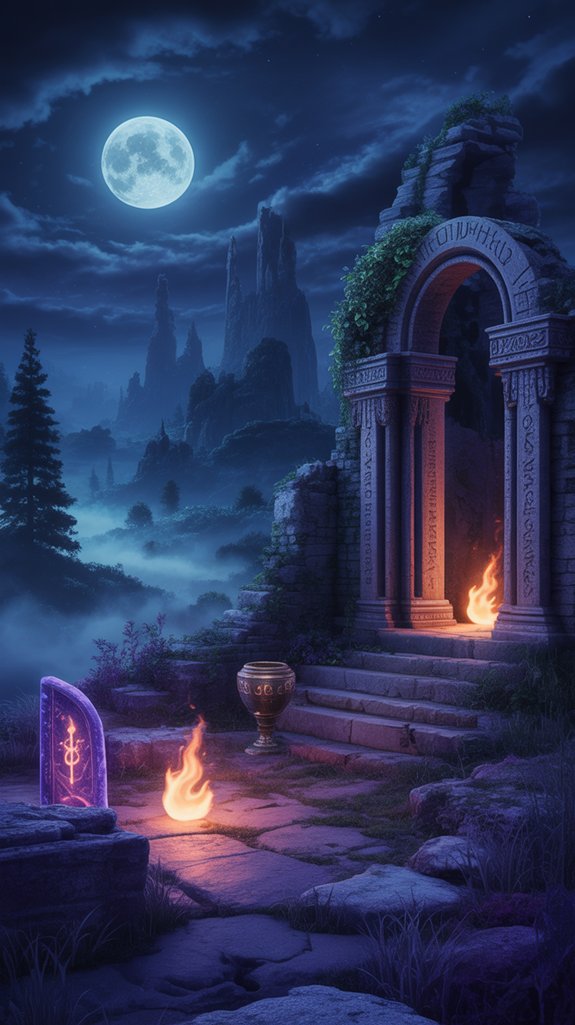
Fire-breathing emerged when agricultural civilizations personified their elemental anxieties through chimeric guardians. Mesopotamia’s Tiamat (circa 3000 BCE) wielded incendiary breath as primordial chaos incarnate, while her draconic progeny—Shamira, Masusu—exhaled flames that signified divine wrath and cosmic disorder. You’ll find this pyrotechnic symbolism threading through Sanskrit Agni’s purifying fire, Biblical Leviathan’s smoke-wreathed nostrils, and Chinese lung dragons commanding storm and season. These creatures weren’t mere monsters but theological ciphers marking boundaries between mortal domain and sacred terror, their breath altering profane matter into ash while testing humanity’s worthiness at civilization’s threshold.
Table of Contents
ToggleKey Takeaways
- Fire-breathing dragons evolved from ancient serpents, transforming from venomous to pyrotechnic representations in agricultural societies’ mythological consciousness.
- Fire symbolized divine authority and judgment, with creatures like Shamira and the Chimera embodying celestial wrath and cosmic disorder.
- Babylonian mythology positioned fire-breathing entities as primordial chaos forces, exemplified by Tiamat’s serpentine form battling Marduk’s order.
- Fire-breathing guardians served as threshold-keepers at sacred boundaries, testing human worthiness through incinerating breath and divine trials.
- Ancient texts used fire as theological cipher marking boundaries between mortal and divine realms, representing purification and transformation.
Dragons Captivate Humanity’s Collective Imagination
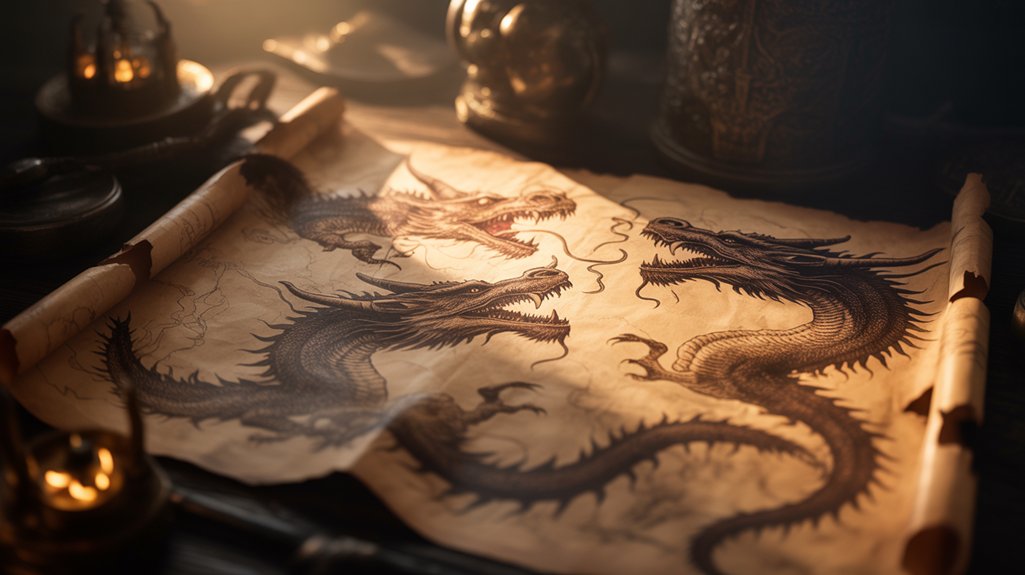
Though serpents had long coiled through humanity’s earliest nightmares, the advent of fire-breathing dragons marked a profound change in our mythological consciousness—one that would reshape how civilizations conceptualized cosmic struggle itself.
You’ll find this alteration embedded within dragon mythology across continents, where cultural evolution reformed protective water-guardians into catastrophic forces wielding flame. Agricultural societies reimagined these creatures as drought-bringers, their eldritch breath scorching fields that serpents once nourished.
The chimeric Shamira of Greco-Roman tradition exemplifies this shift—chaos incarnate, wreathed in fire. Multi-headed venomous beasts from Mesopotamian tablets gradually acquired pyrotechnic capabilities through centuries of reinterpretation.
Ancient serpents transformed through cultural memory, their venom giving way to inferno as civilizations rewrote cosmic terror in flames.
By medieval Europe, fire-breathing dragons dominated illuminated manuscripts, embodying sin itself. This wasn’t mere storytelling embellishment. These flame-wreathed adversaries crystallized humanity’s deepest anxieties about destruction, altering abstract fears into tangible, breathtaking opponents.
They challenged heroes, tested mortals, demanded confrontation. The Greek term “drakōn” itself originally referred to any giant serpent, revealing how the concept expanded from earthbound creatures to winged harbingers of apocalypse. Freedom required facing the fire.
##
When you examine fire’s mythological resonance across civilizations, you’ll discover it embodies far more than mere destruction—it simultaneously represents divine authority, primordial chaos, sacred purification, and protective vigilance.
The Shamira’s flames, emerging from Homer’s 8th century B.C. verses, carried portents of cosmic disorder, while Marduk’s Masusu demonstrated how the same eldritch fire that threatened humanity could also shield it from greater terrors.
This chimeric duality—fire as both annihilator and sanctifier, weapon and ward—reveals why ancient cultures couldn’t simply cast these creatures as villains, instead weaving them into complex theological frameworks where breath becomes both curse and covenant.
In Greek mythology, this same duality manifested through figures like Zeus and Poseidon, whose divine powers over lightning and storms reflected humanity’s ambivalent relationship with elemental forces that could both sustain and devastate.
Divine Power and Wrath
As divine judgment manifests across the mythological landscapes of countless civilizations, fire emerges as the elemental signature of celestial wrath—a searing evidence of power that transcends mortal comprehension.
You’ll discover the Chimera embodying this principle perfectly: its flames represent elemental chaos fused with divine retribution, a chimeric horror dispatched to scourge the defiant.
Ancient texts position fire-breathing entities as threshold guardians, simultaneously protecting sacred treasures and enforcing cosmic order through annihilation.
Consider Agni, whose flames don’t merely destroy—they purify, altering mortal transgression into ash and redemption.
These creatures aren’t random monsters; they’re calculated instruments of divine displeasure, their infernal breath measuring the distance between human hubris and heavenly fury.
Fire becomes language itself, speaking consequences you can’t negotiate, only endure.
Chaos and Destruction Forces
Fire-breathing entities channel primordial entropy—that fundamental disorder preceding creation itself—transforming mythological landscapes into crucibles where civilization confronts its annihilation.
You’ll discover how Shamira and her draconic kin embody chaotic energy, their flames consuming the ordered world humanity desperately constructs. The Hydra’s poisonous exhalations, evolving into conflagrations through successive retellings, reveal this destructive beauty: nature’s raw power manifested through serpentine forms.
Biblical dragons in Job breathe divine retribution, their infernos marking sin’s consequences. These chimeric beings don’t merely destroy—they expose civilization’s fragility.
From Mesopotamian flames to Greek pyres, fire-breathing creatures map humanity’s deepest anxieties about nature’s eldritch forces. They’re chaos incarnate. Beautiful. Terrible. Necessary reminders that order remains forever provisional against entropy’s scorching breath.
Purification Through Flames
Though destruction forms fire’s most visible legacy across mythological traditions, the altering crucible reveals something far more profound—flames don’t merely annihilate; they convert, rendering the impure into sacred essence through temperatures that exceed mortal endurance.
You’ll find this paradox woven throughout Vedic scriptures, where flame rituals consumed offerings, liberating spirits from earthly corruption. The chimeric beast—part lion, serpent, goat—breathed purification alongside devastation.
Sacred changes occurred within these conflagrations: the Phoenix emerged reborn from its pyre, mortality burned away. Ancient priests understood what you’re only beginning to grasp—fire doesn’t simply destroy what it touches. It refines. Purges. Releases.
Through ceremonial flames, your ancestors approached divine favor, their sacrifices ascending as purified smoke, bridging mortal and eldritch domains through controlled immolation.
Guardian Deity Symbolism
Where flames manifest as weapons of change, they simultaneously forge barriers between mortal domains and treasures too potent for profane hands—the fire-breathing guardian stands sentinel at civilization’s most dangerous thresholds.
You’ll discover this archetype crystallized in Tiamat, Mesopotamia’s primordial water-keeper, whose flames protected humanity’s most essential resource.
Guardian myths consistently position these chimeric beings at sacred boundaries, their incandescent breath creating impassable frontiers.
The Shamira of Greco-Roman tradition embodied this duality—chaos incarnate, yet paradoxically preserving cosmic order.
Ancient treasures demanded eldritch protectors whose ferocity matched their sacred charge.
Medieval European narratives altered dragons into divine trials, their defeat symbolizing humanity’s struggle against existential barriers.
These fire-wielders weren’t mere adversaries. They were threshold-keepers, testing worthiness through conflagration.
Mesopotamian Serpent-Dragon Mythology (3000 BCE)
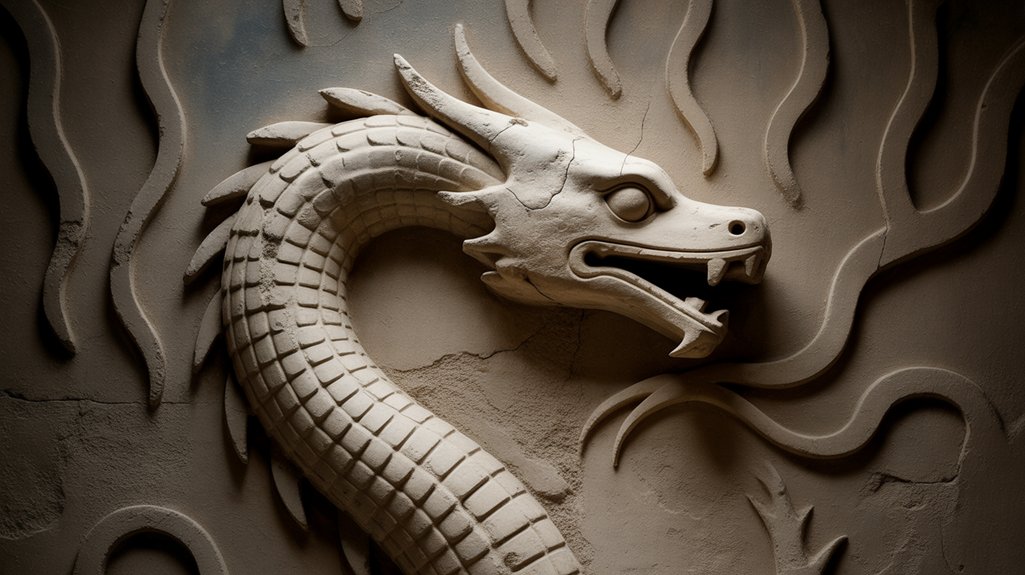
You’ll find the earliest whispers of fire-breathing dragons etched into Babylonian clay tablets, where Tiamat—that eldritch goddess of salt waters and primordial chaos—writhed through creation myths as both mother and destroyer.
The *Enuma Elish* texts, recovered from ancient Mesopotamian sites, reveal how this serpentine deity embodied the churning abyss before existence itself, her chimeric form spawning monsters from the deep.
These sacred writings, dating to approximately 3000 BCE, established foundational imagery linking serpent-dragons to cosmogenic violence, altering formless ocean into ordered world through catastrophic battle.
Tiamat Chaos Goddess Texts
Before the gods imposed their cosmic order upon the primeval waters, Tiamat reigned as the embodiment of chaos itself—a serpentine deity whose name derives from the Akkadian word *ti’amat*, meaning “sea,” and whose essence pervaded the saltwater abyss that predated creation.
You’ll find Tiamat’s symbolism woven throughout the Enuma Elish, circa 3000 BCE, where her chaos representation alters from generative mother to eldritch adversary. She births the pantheon, nurtures divine progeny.
Then rebellion comes. Her chimeric form—dragon-bodied, serpent-scaled—becomes weaponized against Marduk’s ordered universe. When she falls, her corpse becomes cosmos: ribs arching into sky-vaults, flesh compressing into earth.
This isn’t mere destruction mythology. It’s transformation doctrine, showing you how Mesopotamians understood existence itself—chaos subdued but never eliminated, always threatening beneath civilization’s thin veneer.
Babylonian Clay Tablet Discoveries
Seven thousand fragments of baked clay—cuneiform-inscribed, fire-hardened, buried beneath millennia of Mesopotamian dust—survived to transmit dragon-lore that predates written civilization’s formal beginning. You’re witnessing Babylonian mythology’s genesis, where ancient symbolism emerges from archaeological strata.
| Tablet Element | Physical Nature | Mythological Function |
|---|---|---|
| Cuneiform Scripts | Reed-impressed clay | Encoded primordial narratives |
| Tiamat Depictions | Serpentine imagery | Chaos personified |
| Marduk Confrontations | Battle sequences | Order’s triumph |
These discoveries reveal chimeric beings—water-dwelling, eldritch guardians preceding fire’s destructive association. Mesopotamian priests understood dragons as elemental forces, not mere monsters. Salt-encrusted scales. Ocean depths personified. You’re accessing humanity’s earliest attempts to comprehend nature’s terrifying magnificence through mythological frameworks, where serpent-deities embodied primal chaos before cultural evolution altered them into flame-wielding adversaries.
Primordial Ocean Creation Beliefs
When Babylonian cosmogonists inscribed their creation narrative circa 3000 BCE, they positioned Tiamat—primordial ocean personified—at existence’s threshold, neither wholly dragon nor serpent but an aquatic embodiment of pre-creation chaos.
You’ll find her serpentine symbolism intertwined with fertility and catastrophe, a duality revealing how ancient minds perceived water’s eldritch nature. Her battle with Marduk wasn’t mere mythology—it crystallized humanity’s understanding that order must perpetually conquer chaos.
Absu and Masusu, fellow chimeric beings, reinforced this aquatic-draconic connection, their forms emerging from the same primordial chaos that birthed civilizations along the Tigris and Euphrates.
These weren’t superstitions. They were frameworks for comprehending existence itself, with serpent-dragons guarding the liminal boundary between formlessness and creation, destruction and renewal.
Chinese Lung Dragon Traditions

Unlike their Western counterparts—those flame-wreathed terrors of medieval bestiaries—the Chinese Lung dragon emerges from an entirely different cosmological framework, one where water, not fire, flows through its serpentine essence.
Lung Dragon Symbolism manifests through chimeric forms: antlered heads, scaled bodies stretching like rivers themselves. These eldritch guardians commanded storms, summoned rains, guaranteed agricultural prosperity across terraced fields and floodplains. No destructive conflagration here—only life-giving deluge.
| Attribute | Symbolic Meaning |
|---|---|
| Serpentine Body | Flowing water, flexibility |
| Antler-like Horns | Imperial authority, nobility |
| Storm Control | Seasonal renewal, spring |
| Dragon Dance | Protection, fortune |
Within the Four Symbols cosmology, the Lung occupies the eastern quadrant—spring’s domain, where growth conquers dormancy. You’ll find them coiled through imperial architecture, their sinuous forms promising abundance rather than annihilation. The Dragon Boat Festival perpetuates ancient reverence, communities honoring these aquatic sovereigns who brought not scorched earth, but flourishing harvests beneath monsoon skies.
Fire as Divine Power Symbol
Across the threshold between mortal domain and celestial dominion, fire manifests as humanity’s oldest theological cipher—that primordial element through which the divine engraves its will upon creation itself.
You’ll discover sacred flames burning throughout antiquity’s cosmological frameworks, marking boundaries between profane earth and numinous heavens.
These chimeric manifestations reveal fire’s multivalent symbolism:
- Divine judgment scorches the unrighteous while sparing faithful devotees
- Eldritch power courses through flame-breathing deities commanding creation’s architecture
- Metamorphic transformation purifies souls traversing mortality’s limitations
- Primordial chaos yields to cosmic order through controlled conflagration
- Sacred authority emanates from fire-wielding pantheons across civilizations
You’re witnessing how ancient peoples conceptualized ultimate power—raw, incandescent, simultaneously generative and annihilating.
Fire-breathing entities embody this paradox: destruction births renewal, terror inspires awe.
Through sacred flames, gods demonstrate sovereignty over existence’s fundamental forces, establishing fire as theology’s most potent symbol of transcendent authority challenging human autonomy.
Beowulf’s Fiery Dragon Encounter
In Beowulf’s twilight confrontation with the wyrm, you’ll witness how fire-breathing transcends mere physical threat to embody the eldritch forces of cosmic retribution—the dragon’s sulfurous exhalations manifesting both nature’s wrath and the terrible price of accumulated wealth.
The beast’s flames consume not only the Geatish countryside but illuminate the paradox at heroism’s core: Beowulf must destroy the hoard’s guardian to protect his people, yet this very act of protection becomes his funeral pyre.
Gold glitters beneath scaled coils, greed festers in ancient barrows, and destruction follows inevitably—the fire-breath serving as judge, executioner, and purifying force that collapses the boundaries between treasure and curse.
Dragon’s Symbolic Fire Power
Mortality casts its longest shadow when Beowulf, aged and battle-worn, confronts the wyrm whose incandescent breath modifies the Geatish landscape into ash and ruin.
You’ll discover this dragon mythology transcends mere physical threat—the creature’s flames embody corrupting avarice, nature’s eldritch fury unchained.
Fire symbolism here operates dually: destroyer and illuminator, revealing hero and hoard alike. The beast’s chimeric essence, simultaneously serpentine guardian and apocalyptic harbinger, challenges your understanding of heroic triumph.
Its breath doesn’t simply incinerate; it purges, alters, annihilates the boundary between glory and oblivion. This conflagration represents wealth’s seductive poison, the inevitable price of legendary deeds.
Ancient poets understood: fire liberates and enslaves, creates and unmakes. The dragon’s incandescent exhalations strip away illusion, leaving only truth’s terrible radiance—death approaches all warriors.
Beowulf’s Heroic Final Battle
Three centuries of peaceful rule culminate in Beowulf’s grim reckoning with the wyrm that awakens beneath his kingdom’s bedrock.
You witness how Beowulf’s legacy evolves from youthful glory into aged sacrifice, as the eldritch serpent’s flames consume both flesh and chronicle.
The dragon’s fire isn’t merely destructive—it’s revelatory, exposing mortality’s inexorable claim upon even legendary warriors.
Dragon symbolism here transcends simple antagonism; the creature embodies wealth’s chimeric nature, hoarding treasures that bring only devastation when disturbed.
You observe sovereignty meeting its terminus in conflagration, where courage can’t shield against time’s erosion or eldritch flame.
The hero’s final stand against pyroclastic fury demonstrates that vulnerability, not invincibility, defines true heroism.
Death by dragonfire becomes apotheosis.
Gold, Greed, and Destruction
When the nameless thief’s trembling hands breach the barrow’s threshold in 700 CE Geatland, he doesn’t merely steal a gilded cup—he ruptures a covenant between ancient wealth and serpentine guardian that has endured for three hundred winters.
The dragon’s hoard, accumulated through conquest or inheritance the poet deliberately obscures, changes from inert metal into catalyst for apocalypse the moment human avarice disturbs its arrangement.
You witness here destructive greed’s alteration into literal flame, as the wyrm’s fire-breath becomes physical manifestation of corruption’s scorching touch.
The gold hoard shifts from passive treasure into active destroyer, its glittering surfaces reflecting not prosperity but imminent annihilation.
This eldritch fusion of material wealth and serpentine rage illuminates how ancient cultures understood avarice as force capable of consuming entire kingdoms—a truth Beowulf’s charred body confirms.
Tolkien’s Smaug Reimagined Dragons
No literary creation has more profoundly reshaped the modern conception of fire-breathing dragons than J.R.R. Tolkien’s Smaug, who surpasses the chimeric beasts of antiquity through literary complexity unmatched in dragon mythology.
You’ll discover Smaug’s cunning intellect raises him beyond mere monster, positioning him as both philosopher and predator.
His reimagining encompasses:
- Fire as metaphysical manifestation of destructive desire, incinerating dwarven kingdoms
- Psychological manipulation wielded alongside physical devastation
- Greed altered into existential condition rather than simple vice
- Linguistic prowess revealing eldritch intelligence
- Bridge between ancient wyrm-lore and contemporary narrative sophistication
Tolkien drew upon Norse sagas, Anglo-Saxon epic tradition, synthesizing millennia of fire-breathing symbolism into singular being.
When Bilbo confronts this magnificent terror, you witness the hero’s journey crystallized—courage facing overwhelming power.
Smaug’s scales reflect ancestral fears; his voice carries weight of forgotten tongues.
Through this dragon, destructive desire becomes archetypal force, reminding you that true monsters possess both flame and philosophy.
Evolutionary Fear Response Studies
Before dragons ever materialized in parchment and verse, your ancestors’ neural architecture had already begun encoding the template for such terrors. The amygdala—that ancient sentinel nestled deep within your limbic system—recognizes chimeric predators instinctively, fusing snake, raptor, and flame into singular dread.
Evolutionary psychology reveals how millions of years sculpted these primal instincts, carving pathways that ignite when you encounter fire-breathing behemoths, whether real or imagined. Your brain doesn’t distinguish between volcanic fury and draconic breath. Both trigger identical survival mechanisms.
Your neural circuitry cannot differentiate between mythical dragons and molten catastrophe—both awaken the same ancestral terror hardwired across millennia.
Studies demonstrate that vivid depictions of flame-wielding creatures activate fear responses more intensely than mundane threats, precisely because they combine multiple dangers—predation, conflagration, chaos—into one eldritch form.
Cross-cultural mythologies didn’t randomly converge on fire-breathing entities. They crystallized humanity’s collective attempts to personify uncontrollable natural forces, converting abstract environmental terror into something nameable, comprehensible.
The dragon became your species’ answer to understanding what can’t be controlled, only survived or appeased.
Modern Pop Culture Dragon Influence
As medieval manuscripts gave way to silver screens and pixel-rendered worlds, the dragon underwent a metamorphosis as profound as any alchemical change.
You’ll witness this dragon evolution most vividly in contemporary narratives—Game of Thrones, How to Train Your Dragon—where chimeric beasts transcend their ancient roles as harbingers of chaos. This cultural adaptation changes fire-breathing terrors into companions, protectors, even heroes.
Where Beowulf’s wyrm hoarded gold in darkness, your modern dragon shares adventures. The eldritch flame remains, yet its meaning shifts: no longer purely destructive, it illuminates paths toward liberation.
Interactive domains—The Elder Scrolls, Dungeons & Dragons—invite you to inhabit these liminal spaces, engaging directly with creatures once feared.
The merchandising phenomenon reveals something deeper: society’s hunger for reclaimed wildness, for untamed power reframed as ally rather than adversary.
You’re witnessing not corruption of ancient symbolism but continuation, adaptation. Dragons breathe fire still, yet now it’s yours to wield.
Fire-Breathing Myths Endure Today
Though centuries separate us from the scribes who first etched draconic forms onto parchment, you’ll find their fire-breathing progeny alive in unexpected corners of contemporary existence. The fire breathing symbolism persists because it speaks to primal truths about power, alteration, destruction.
You witness mythical evolution in corporate logos that utilize draconic ferocity, in environmental movements warning of humanity’s scorched-earth trajectory, in technological metaphors describing computing power as “breathing fire.” These aren’t mere aesthetic borrowings—they’re ancestral archetypes reasserting themselves through modern vessels.
Ancient Mesopotamian chaos-serpents, medieval European wyrms, Eastern lung dragons: their flames illuminate your collective unconscious. The chimeric fusion of reptile and inferno remains culturally potent because it embodies what you fear and revere simultaneously.
Liberation movements adopt the dragon’s refusal to submit. Artists channel its eldritch intensity. You don’t simply remember these myths; you inhabit them, perpetuating narratives first whispered in temple shadows, ensuring fire-breathers endure as eternal companions to human imagination.
Frequently Asked Questions
What Biological Mechanisms Would Allow a Real Creature to Breathe Fire?
You’d need extraordinary fire chemistry within specialized organs—combustible compounds like methane or hydrogen produced in sealed chambers, mixed with catalytic enzymes triggering ignition upon exhalation.
This evolutionary adaptation would require heat-resistant tissues, perhaps ceramic-like proteins coating the throat, chimeric modifications to respiratory systems.
Ancient texts whisper of such mechanisms, describing eldritch creatures with stone-lined gullets, phosphorescent secretions.
Biology trembles at this threshold between possible and impossible, where liberation from natural law beckons through radical metamorphosis.
Are There Any Historical Accounts of Fire-Breathing Animals in Nature?
You’ll find no verified natural fire-breathers in documented history—only mythical creatures dwelling in humanity’s chimeric imagination.
Ancient texts juxtapose serpentine dragons against phoenixes, reality against symbol. These pyrotechnic beasts emerged from animal symbolism: komodo dragons’ venomous bite, bombardier beetles’ explosive spray, lightning-struck forests.
Medieval bestiaries catalogued eldritch flame-spewers as fact, yet empirical evidence remains absent.
You’re left with this truth: fire-breathing exists solely within our collective psyche, where wonder defies biological constraint.
How Do Different Cultures Explain Where Dragons Obtained Their Fire Ability?
You’ll discover cultural interpretations across continents attribute draconic flame to divine sources—Chinese long received celestial yang essence, European wyrms consumed volcanic sulfur and brimstone, Mesopotamian Tiamat embodied primordial chaos itself.
These mythological origins weren’t mere fantasy but sacred cosmology. The Aztecs believed Xiuhcoatl, the fire serpent, carried the sun’s very essence.
Each tradition preserves authentic wisdom about elemental forces. Ancient fire itself, eldritch and untamed, became chimeric flesh through humanity’s need to understand nature’s most devastating, most liberating power.
What Weapons or Methods Were Believed Most Effective Against Fire-Breathing Dragons?
You’d need consecrated blades forged in moonlight, wielded through sword techniques passed down from dragonslayers who understood the chimeric beast’s vulnerabilities.
Ancient texts reveal magical artifacts—the Sigurd legends speak of Gram, that eldritch blade cutting through Fafnir’s scales. Cold iron. Blessed water.
Your freedom depends on knowledge these cultures preserved: strike between scales during the creature’s inhalation, when fire retreats inward.
The Nordic völvas knew. The Chinese immortals understood. Such wisdom liberates those who’d face dragons.
Did Any Ancient Civilizations Worship Fire-Breathing Dragons as Actual Deities?
You’ll discover that ancient dragon worship as formal religion rarely existed.
Mesopotamian Tiamat embodied primordial chaos—revered, feared, yet not strictly worshipped as benevolent deity.
China’s Long held celestial power, receiving offerings and veneration, though scholars debate true theological status versus symbolic reverence.
These chimeric beings transcended simple ancient deities classification.
They represented elemental forces, cosmic balance, the numinous edge between creation and destruction.
Worship implied supplication; dragons demanded acknowledgment of nature’s eldritch sovereignty over human presumption.
Conclusion
You’ve traversed millennia of chimeric visions, from Mesopotamia’s eldritch serpents to Smaug’s cinematic flames. These fire-breathing entities aren’t mere fantasy—they’re humanity’s primal vocabulary, encoding divine terror into scalded flesh and ash. Whether you’re reading cuneiform tablets or watching CGI dragons soar, you’re participating in an unbroken ritual, a sacred conversation spanning cultures and epochs. The dragon’s breath burns eternal. Not metaphorically. Literally. In our collective psyche, that flame never dies.


